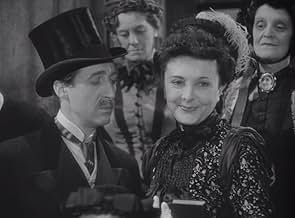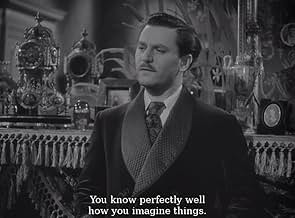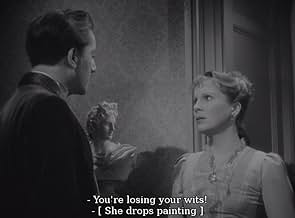IMDb रेटिंग
7.3/10
5.7 हज़ार
आपकी रेटिंग
अपनी भाषा में प्लॉट जोड़ेंTwenty years after the murder of Alice Barlow, her house is finally occupied again. However, the husband from the couple who has moved in has a secret that he will do anything to keep hidden... सभी पढ़ेंTwenty years after the murder of Alice Barlow, her house is finally occupied again. However, the husband from the couple who has moved in has a secret that he will do anything to keep hidden.Twenty years after the murder of Alice Barlow, her house is finally occupied again. However, the husband from the couple who has moved in has a secret that he will do anything to keep hidden.
- निर्देशक
- लेखक
- स्टार
Alfred Atkins
- Bit Role
- (बिना क्रेडिट के)
Edwin Ellis
- Bit Role
- (बिना क्रेडिट के)
Kathleen Harrison
- Bit Role
- (बिना क्रेडिट के)
Katie Johnson
- Alice Barlow's Maid
- (बिना क्रेडिट के)
Molly Raynor
- Bit Role
- (बिना क्रेडिट के)
फ़ीचर्ड समीक्षाएं
It is inevitable that this 1940 film and the 1944 "remake" with Charles Boyer and Ingrid Bergman are going to be compared, and people will have different opinions as to which is the better version.
To me, both 'Gaslight' films are great in their own way, and this reviewer ranks them equally, yet with one or two things in things that are done better in the other. Like the 1944 film (the only real drawback to that film was the uneven performance of Joseph Cotton), there is very little wrong here. The secondary characters could have been better fleshed out, and while Richard Adinsell's music score is suitably ominous Bonislau Kaper's score for the later version has more atmosphere, subtlety and tension.
However, while not as glossy as the later film 'Gaslight' (1940) regardless is incredibly well-made. It's shot beautifully and menacingly, is hauntingly lit and has sets that are picturesque yet give off a great amount of dread while over-stating it. It's intelligently and suspensefully directed by then-famous-and-well-regarded, now-almost-forgotten (undeservedly) Thorald Dickinson.
The script is thought-provoking and tense, everything feels relevant to what's going on and nothing seemed padded. Tighter-paced and more theatrical somewhat, the story never creaks and is leaden with tension and suspense with nothing obvious that came over as unnecessary or clumsy.
Performances are great here and hardly inferior to those in the later film, despite being less familiar. Anton Walbrook, while not as subtle as Charles Boyer, is terrifying and a huge part as to why the film is as atmospheric as it is. Diana Wynward demonstrates Bella's vulnerability incredibly movingly with no histrionics and she's hardly dull either (though the character has more range and depth to her in the 1944 version).
Frank Petingell looks more comfortable than Joseph Cotton, his performance is more even (though Cotton was hardly bad), the character is better written and he is more believable as a police officer (where Cotton's performance particularly fell down on). Robert Newton is a strong presence in an early role, and Cathleen Cordell is a hoot as Nancy.
All in all, despite being in the shadow of the 1944 'Gaslight' in popularity the earlier 1940 film doesn't deserve to be, because it is every bit as great. 9/10 Bethany Cox
To me, both 'Gaslight' films are great in their own way, and this reviewer ranks them equally, yet with one or two things in things that are done better in the other. Like the 1944 film (the only real drawback to that film was the uneven performance of Joseph Cotton), there is very little wrong here. The secondary characters could have been better fleshed out, and while Richard Adinsell's music score is suitably ominous Bonislau Kaper's score for the later version has more atmosphere, subtlety and tension.
However, while not as glossy as the later film 'Gaslight' (1940) regardless is incredibly well-made. It's shot beautifully and menacingly, is hauntingly lit and has sets that are picturesque yet give off a great amount of dread while over-stating it. It's intelligently and suspensefully directed by then-famous-and-well-regarded, now-almost-forgotten (undeservedly) Thorald Dickinson.
The script is thought-provoking and tense, everything feels relevant to what's going on and nothing seemed padded. Tighter-paced and more theatrical somewhat, the story never creaks and is leaden with tension and suspense with nothing obvious that came over as unnecessary or clumsy.
Performances are great here and hardly inferior to those in the later film, despite being less familiar. Anton Walbrook, while not as subtle as Charles Boyer, is terrifying and a huge part as to why the film is as atmospheric as it is. Diana Wynward demonstrates Bella's vulnerability incredibly movingly with no histrionics and she's hardly dull either (though the character has more range and depth to her in the 1944 version).
Frank Petingell looks more comfortable than Joseph Cotton, his performance is more even (though Cotton was hardly bad), the character is better written and he is more believable as a police officer (where Cotton's performance particularly fell down on). Robert Newton is a strong presence in an early role, and Cathleen Cordell is a hoot as Nancy.
All in all, despite being in the shadow of the 1944 'Gaslight' in popularity the earlier 1940 film doesn't deserve to be, because it is every bit as great. 9/10 Bethany Cox
The later version is Hollywood English, which I sometimes think is a downtown section of Hollywood Transylvanian. Believe me, the original is the real thing, from the small details up to the social assumptions: it's recognisably English. As such, the thriller is grounded in a reality that the later version can never have. And so it's scary! Of course, I admit that this justification of the original might be a lot less convincing if you're reading my words on the other side of the world...
As for the difficulty of getting hold of a copy, well every few years it's shown on one TV station or another over here, so there has to be a good copy somewhere out there.
As for the difficulty of getting hold of a copy, well every few years it's shown on one TV station or another over here, so there has to be a good copy somewhere out there.
Although Ingrid Bergman and Charles Boyer got a lot of press for the movie GASLIGHT, the film was actually a remake of a British film made only a few years earlier. It seems that the big-wigs at the studio wanted to remake the film but pretend that it was an original Hollywood production so they bought up the prints and the remade film went on to be considered a "classic". However, recently the ORIGINAL version from 1940 has been discovered and has been shown on Turner Classic Movies.
Having seen both versions, I found them awfully similar--but I would have to say that I preferred the original. The wonderful Anton Walbrook was a wonderful and even more menacing husband and I just could see no reason why the movie should have been remade. It's really a shame, too, as I am sure that those associated with the original must have wished they'd gotten all the attention the 1944 version received.
My advice is see them both. However, if you only plan on seeing one, see this one--it's just a better film!
Having seen both versions, I found them awfully similar--but I would have to say that I preferred the original. The wonderful Anton Walbrook was a wonderful and even more menacing husband and I just could see no reason why the movie should have been remade. It's really a shame, too, as I am sure that those associated with the original must have wished they'd gotten all the attention the 1944 version received.
My advice is see them both. However, if you only plan on seeing one, see this one--it's just a better film!
Let's face it - the British do psychological suspense VERY well! This 1940 British production is more streamlined and suspenseful than the MGM version of 1944, as it sticks more closely to Patrick Hamilton's play. The MGM version had more 'back-story' and padding to it. I love Diana Wynyard - she was lovely to look at and seemed wonderfully edgy and vulnerable - I wasn't surprised to learn that she played the anguished mother in the West End production of THE BAD SEED - she's really only remembered today for this film and CAVALCADE (1933), but she's definitely worth watching. Anton Walbrook is a little hammier than Boyer was, and there are those obvious streaks in his hair to make him look a little older - but he has a wonderful moment at the films end when, quite suddenly, his eyes go wild and you can tell that he's completely lost his mind - might have been a nice touch if the 1944 had included such a moment. Highly recommended.
I've noticed that people seem surprised that MGM attempted to suppress the 1940 British version of GASLIGHT to avoid any competition with their version. I don't know why anyone should be surprised - Hollywood's business is a cut-throat one: remember that L.B. Mayer, along with Jack Warner and others, offered to buy CITIZEN KANE from RKO and then destroy it, all to appease William R. Hearst - fortunately they didn't (just imagine the history of film since 1941 if they had!) And although MGM didn't destroy all prints of GASLIGHT, they did manage to keep it out of sight for many years - I think I first saw it on a cable station in the early 1980s - I tuned in expecting Boyer and Bergman and got Walbrook and Wynyard - as it turned out I didn't mind at all, and have enjoyed it many times since! MGM did the same thing with Paramount's 1932 DR. JEKYLL AND MR. HYDE which, except for an occasional screening, went unseen (but much written about) until it came out on video around 1990 (under the MGM label - imagine that!)
I've noticed that people seem surprised that MGM attempted to suppress the 1940 British version of GASLIGHT to avoid any competition with their version. I don't know why anyone should be surprised - Hollywood's business is a cut-throat one: remember that L.B. Mayer, along with Jack Warner and others, offered to buy CITIZEN KANE from RKO and then destroy it, all to appease William R. Hearst - fortunately they didn't (just imagine the history of film since 1941 if they had!) And although MGM didn't destroy all prints of GASLIGHT, they did manage to keep it out of sight for many years - I think I first saw it on a cable station in the early 1980s - I tuned in expecting Boyer and Bergman and got Walbrook and Wynyard - as it turned out I didn't mind at all, and have enjoyed it many times since! MGM did the same thing with Paramount's 1932 DR. JEKYLL AND MR. HYDE which, except for an occasional screening, went unseen (but much written about) until it came out on video around 1990 (under the MGM label - imagine that!)
I have liked the Gaslight films for many years and was surprised and delighted recently to find both versions together on an American DVD ! Miracles will never cease, I thought!
I have read various comments from people trying to compare these two films. I will not fall into this trap - I liked each film as much as the other..true, Walbrook looks more evil as a villain than Charles BOyer, and the 1940 version is perhaps a little more picturesque with the sets ( carriages, children etc ) but both films were very well done. The picture quality of the 1944 version is obviously better than that of 1940, and I had read somewhere that they had actually tried to get the print of the 1940 version destroyed as to have only the 1944 version available. What a horrible thought that someone could actually have wanted to do that !
So, they are both great suspense films and the black and white only serves to enhance the already seedy atmosphere ! Well worth several viewings !!!
I have read various comments from people trying to compare these two films. I will not fall into this trap - I liked each film as much as the other..true, Walbrook looks more evil as a villain than Charles BOyer, and the 1940 version is perhaps a little more picturesque with the sets ( carriages, children etc ) but both films were very well done. The picture quality of the 1944 version is obviously better than that of 1940, and I had read somewhere that they had actually tried to get the print of the 1940 version destroyed as to have only the 1944 version available. What a horrible thought that someone could actually have wanted to do that !
So, they are both great suspense films and the black and white only serves to enhance the already seedy atmosphere ! Well worth several viewings !!!
क्या आपको पता है
- ट्रिवियाWhen MGM remade the film with Charles Boyer and Ingrid Bergman, the studio attempted to have all prints of this earlier version destroyed. Fortunately, several prints escaped the fire (in fact, it is believed that director Thorold Dickinson surreptitiously struck a print himself before the negative was lost).
- गूफ़After the murder of the old lady in 1865, a police constable is shown blowing a whistle to summon assistance. Whistles were not used by the Metropolitan Police until the 1870s; prior to that they used a football rattle to attract attention.
- कनेक्शनFeatured in The Kenny Report: 3 सितम्बर 2024 को प्रसारित एपिसोड (2024)
- साउंडट्रैकThe Can-Can
(uncredited)
from "Orpheus in the Underworld"
Music by Jacques Offenbach
Arranged by Richard Addinsell
Played at the music hall and danced to by The Darmora Ballet
टॉप पसंद
रेटिंग देने के लिए साइन-इन करें और वैयक्तिकृत सुझावों के लिए वॉचलिस्ट करें
- How long is Gaslight?Alexa द्वारा संचालित
विवरण
- चलने की अवधि1 घंटा 24 मिनट
- रंग
- पक्ष अनुपात
- 1.37 : 1
इस पेज में योगदान दें
किसी बदलाव का सुझाव दें या अनुपलब्ध कॉन्टेंट जोड़ें


































